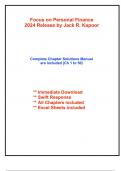Focus on Personal Finance
2024 Release by Jack R. Kapoor
Complete Chapter Solutions Manual
are included (Ch 1 to 50)
** Immediate Download
** Swift Response
** All Chapters included
** Excel Sheets included
,Table of Contents are given below
1. Personal Financial Planning in Action
2. Money Management Skills
3. Taxes in Your Financial Plan
4. Financial Services Savings Plans and Payment Accounts
5. Consumer Credit Advantages, Disadvantages, Sources, and Costs
6. Consumer Purchasing and Wise Buying Strategies
7. Selecting and Financing Housing
8. Home and Automobile Insurance
9. Health and Disability Income Insurance
10. Financial Planning with Life Insurance
11. Investing Basics and Evaluating Bonds
12. Investing in Stocks
13. Investing in Mutual Funds
14. Starting Early Retirement and Estate Planning
,Solutions Manual organized in reverse order, with the last
chapter displayed first, to ensure that all chapters are included in
this document. (Complete Chapters included Ch14-1)
Kapoor, Focus on Personal Finance
Chapter 14 Solutions
1. Shelly’s assets include money in checking and saving accounts, investments in stocks and
mutual funds, and personal property, such as furniture, appliances, an automobile, coin
collection, and jewelry. Shelly calculates that her total assets are $165,200. Her current
unpaid bills, including an auto loan, credit card balances, and taxes total $21,300. Calculate
Shelly’s net worth. (LO 14.1)
Net worth = Assets − Liabilities
Shelly’s net worth is $165,200 − $21,300 = $143,900
2. Prepare your net worth statement using the assets − liabilities = net worth equation. (LO
14.1)
The purpose of this activity is to review one’s assets to make sure they are suitable
for retirement. After thoroughly reviewing assets, one can estimate spending needs
during the retirement years.
3. Roy owns a Lexus worth $60,000. He owns a home worth $375,000. He has a checking
account with $1,800 in it and a savings account with $2,900 in it. He has a mutual fund
worth $215,000. His personal assets are worth $100,000. He still owes $45,000 on his car,
$170,000 on his home, and has a balance on his credit card of $1,850. What is Roy’s net
worth? (LO 14.1)
Assets Liabilities
Car $60,000 Car $45,000
Home 375,000 Home 170,000
Checking account 1,800 Credit card 1,850
Savings account 2,900
Mutual funds 215,000
Personal assets 100,000
Total 754,700 216,850
Net worth $754,700 − $216,850 = $537,850
, 4. Calculate approximately how much money an older (age 65+) household with an annual
income of $50,000 and annual expenditure of $48,000 spends on housing each year. (Hint:
Use Exhibit 14-3.) (LO 14.1)
$48,000 × 35.7% = $17,136
5. Using Exhibit 14-3, calculate approximately how much money the older (age 65+) household
from Problem 4 spends on medical care. (LO 14.1)
$48,000 × 13.8% = $6,624
6. Ruby is 25 and has a good job at a biotechnology company. She currently has $10,000 in
an IRA, an important part of her retirement nest egg. She believes her IRA will grow at an
annual rate of 8%, and she plans to leave it untouched until she retires at age 65. Ruby
estimates that she will need $875,000 in her total retirement nest egg by the time she is 65
in order to have retirement income of $20,000 a year (she expects that Social Security will
pay her an additional $15,000 a year). (LO 14.2)
a. How much will Ruby’s IRA be worth when she needs to start withdrawing money from it
when she retires? (Hint: Use future value, compounded sum, and online calculator.)
Years to retirement = 40
Her current IRA = $10,000
Annual growth rate = 8%
Future value (compounded sum) after 40 years at 8% growth = $217,250
b. How much money will she have to accumulate in her company’s 401(k) plan over the
next 40 years in order to reach her retirement income goal?
Total nest egg required by age 65 = $875,000
Money she’ll have to accumulate in her company’s 401(k) = $875,000 − $217,250 =
$657,750
7. Gene and Dixie, husband and wife (ages 35 and 32), both work. They have an adjusted
gross income of $95,000 in 2023, and they are filing a joint income tax return. Both have an
employer-provided retirement plan at work. What is the maximum IRA contribution they can
make? How much of that contribution is tax deductible? (LO 14.2)
In 2023, they can contribute a total of $13,000 (all tax deductible).




